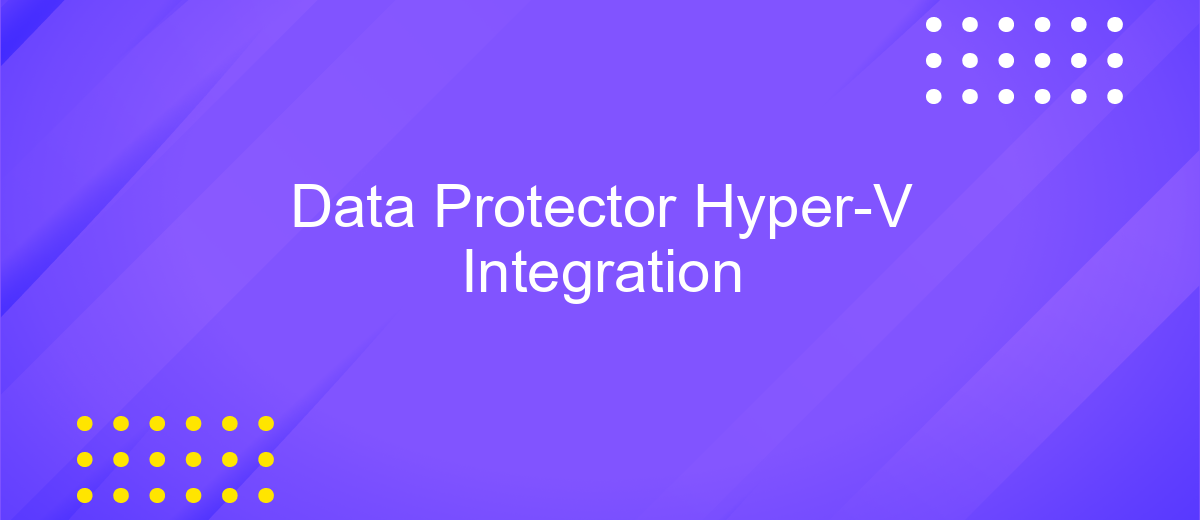Data Protector Hyper-V Integration
Data Protector Hyper-V Integration provides a robust solution for safeguarding virtual environments. By seamlessly integrating with Microsoft Hyper-V, this tool ensures efficient backup and recovery processes, minimizing downtime and data loss. It offers advanced features such as granular recovery and automated workflows, making it an essential component for businesses aiming to protect their critical virtualized infrastructure.
Introduction
Data Protector Hyper-V Integration is a vital component for organizations aiming to safeguard their virtual environments. This integration ensures seamless backup and recovery processes, providing comprehensive data protection for Hyper-V virtual machines. By leveraging this solution, businesses can minimize downtime, prevent data loss, and enhance overall IT resilience.
- Efficient backup and recovery of Hyper-V virtual machines
- Minimized downtime and data loss prevention
- Enhanced IT resilience and business continuity
- Seamless integration with existing IT infrastructure
- Scalable solution to meet growing business needs
In today's fast-paced digital landscape, maintaining the integrity and availability of virtual environments is crucial. Data Protector Hyper-V Integration offers a robust and scalable solution tailored to meet the demands of modern enterprises. By incorporating this technology, organizations can ensure their critical data remains secure, accessible, and recoverable, thereby supporting uninterrupted business operations.
Benefits

Integrating Data Protector with Hyper-V offers a range of benefits that streamline data management and enhance system reliability. One of the primary advantages is the seamless backup and recovery process, which ensures that virtual machines (VMs) are safeguarded against data loss and can be quickly restored in case of failures. This integration also provides automated data protection, reducing the need for manual intervention and minimizing human errors, thus enhancing overall operational efficiency.
Furthermore, the use of services like ApiX-Drive can significantly simplify the setup and management of these integrations. ApiX-Drive allows for easy configuration and synchronization between Data Protector and Hyper-V, ensuring that data flows smoothly and securely between systems. This not only saves time but also ensures that data protection policies are consistently applied across the virtual environment. By leveraging such tools, organizations can achieve a higher level of data integrity and security, ultimately leading to more resilient and dependable IT infrastructures.
Configuration

Configuring Data Protector for Hyper-V integration involves several key steps to ensure seamless backup and recovery operations. Proper configuration guarantees that your virtual environments are protected and that data integrity is maintained.
- Install Data Protector on the management server and ensure it is updated to the latest version.
- On the Hyper-V host, install the Data Protector Disk Agent and the VEPA (Virtual Environment Protection Agent).
- Configure the Data Protector Cell Manager to recognize the Hyper-V host by adding it to the client list.
- Set up backup specifications tailored to your Hyper-V virtual machines, including scheduling and retention policies.
- Test the backup and restore processes to verify that the configuration is correct and that data can be recovered without issues.
By following these steps, you can ensure that your Hyper-V environment is properly integrated with Data Protector. This setup not only enhances data protection but also simplifies the process of managing backups and restores, providing peace of mind and operational efficiency.
Deployment Scenarios

Deploying Data Protector in a Hyper-V environment involves several scenarios tailored to meet diverse organizational needs. Each scenario ensures efficient data protection and seamless integration with existing infrastructure.
One common deployment scenario is the centralized backup model, where a single Data Protector Cell Manager oversees multiple Hyper-V hosts. This model streamlines management and reduces administrative overhead.
- Centralized Backup: A single Cell Manager for multiple Hyper-V hosts.
- Distributed Backup: Each Hyper-V host has its own Cell Manager.
- Hybrid Model: Combines centralized and distributed approaches for flexibility.
- Cloud Integration: Extends backup capabilities to cloud environments.
In choosing the appropriate deployment scenario, organizations must consider factors such as the scale of their Hyper-V environment, existing IT infrastructure, and specific backup requirements. Proper planning and execution ensure that Data Protector delivers optimal performance and reliability in protecting critical data assets.
Best Practices
When implementing Data Protector Hyper-V Integration, it is crucial to ensure that all virtual machines (VMs) are properly backed up and restored. Regularly test backup and recovery procedures to guarantee data integrity and minimize downtime in case of failures. Utilize incremental backups to save time and storage space, and ensure that the backup schedule aligns with your organization's needs. Additionally, keep your Data Protector software and Hyper-V environment updated to benefit from the latest security patches and features.
For seamless integration and automation, consider using services like ApiX-Drive. ApiX-Drive can help you automate data synchronization between Data Protector and other systems, reducing manual effort and the risk of human error. Set up notifications to stay informed about the status of your backups and any potential issues. By leveraging such tools, you can enhance the efficiency and reliability of your Data Protector Hyper-V Integration, ensuring that your data protection strategies are both robust and streamlined.
FAQ
What is Data Protector Hyper-V Integration?
How does Data Protector Hyper-V Integration work?
What are the prerequisites for using Data Protector Hyper-V Integration?
Can I automate the backup process for Hyper-V VMs using Data Protector?
What types of Hyper-V environments are supported by Data Protector?
Time is the most valuable resource for business today. Almost half of it is wasted on routine tasks. Your employees are constantly forced to perform monotonous tasks that are difficult to classify as important and specialized. You can leave everything as it is by hiring additional employees, or you can automate most of the business processes using the ApiX-Drive online connector to get rid of unnecessary time and money expenses once and for all. The choice is yours!

